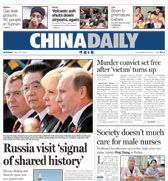

SHANGHAI - While most people at the 2010 Shanghai World Expo have spent their time looking towards the future, I spend much of my Expo experience thinking about the past.
My childhood was filled with stories of the 1939 World Fair in New York and a favorite dinner-table conversation of my grandparents. The Fair was a tipping point in terms of the technological achievements humanity could accomplish and a defining moment in my grandparents' young lives. Their inability to forget the dazzling lights, exotic pavilions and electrifying performances their eyes saw 70 years ago, is something that has always amazed me and brought me to Shanghai to discover what makes Expos so unforgettable.
Although it is natural for us in 2010 to concentrate on the opportunities, growth, and promise that lie in the future, thinking about Expo's past can help us understand this Expo's future.
I came to work at the Shanghai Expo because I remember the glow in my grandfather's eyes whenever "1939" came up. For his whole life, my grandfather had dreamed of visiting faraway places. The son of Irish immigrants and a teenager in the Great Depression, my grandfather was in no position to fulfill this childhood dream.
When New York announced it would hold the next World Fair, he was quick to sign up for any job that would keep him bouncing from pavilion to pavilion, world to world. He attained a job pushing ordinary visitors and celebrities alike in rickshaw like push carts from pavilion to pavilion.
The Fair was "Heaven on Earth" when it opened. Its "World of Tomorrow" theme stood in stark contrast to the poverty-stricken reality of the Great Depression. The fair featured the latest technology in General Motor automobiles, sky-high parachute jumps, the 700-foot "tryclone," and dozens upon dozens of glittering lights. The message of humanity using innovation and technology to build a better future resonated deeply with a generation that could not escape their present, impoverished reality.
My grandfather enjoyed every minute pushing his cart. He met many famous 1930s Hollywood stars such as Cary Grant, James Cagney, and Carole Lombard and collected their signatures on his wide-brimmed safari hat, part of the American uniform. He sometimes even pushed his girlfriend around the fair, who eventually became my grandmother.
Long after the fair ended, the Great Depression phased into World War II, and long after my grandparents had comfortably settled in with children and grandchildren, 1939 was still thought of with a sense of excitement and promise, a time where they had seen the future and it was perfect.
I came to work at the 2010 Shanghai World Expo to see if I could experience the same wonder and excitement my grandparents had experienced in 1939.
From the start, I was literally and figuratively a world apart from them. My grandfather worked in the fair so that he could travel without the expenses of leaving his hometown -- I traveled 7,376 miles from home to work here.
My grandfather would visit the China pavilion to get a sense of the exotic Far East and see pictures of the glamorous 1930s' Shanghai -- I live and work here for the duration of the Expo.
He pushed carts in the hot sun day after day -- I ride special Expo shuttle buses to go to various important events. I am also here because I learned Chinese after four years of college, something my grandfather never had.
Although my experience is different, the Shanghai World Expo has also given me the same sense of possibility and enchantment. From the majestic architecture of the Chinese pavilion to the daily rush of visitors lining up for each pavilion, I finally see what a World Expo is about. Every night I see the parade of floats and lights that runs down the main avenue and am completely transfixed. The excitement of visitors and the daily displays of international culture, food and dance make this Expo unforgettable.
When I look out of my window at downtown Shanghai and the 2010 Expo, I cannot but stop thinking of 1939's "World of Tomorrow" theme. Whether you walk through the bright pavilions or look out at the Shanghai skyline, you cannot help but realize that we have finally made it to tomorrow. [ The 2010 Expo, which showcases the progress in international relations and technology, coupled with the splendor of modern Shanghai, is the future that previous World Fairs could only dream of. The technologies and constructions displayed in 1939 are surpassed by the Jin Mao Tower, Pearl Tower and the many pavilions in Pudong and Puxi.
Looking at the Shanghai World Expo in the context of the past gives us proof, not just hope, that the themes of World Fairs can be achieved. At this Expo, our definition of what "tomorrow" is has changed. "Better City, Better Life" is about people coming together to improve their communities and their Earth.
Our grandchildren will enjoy a better city, better life envisioned by the 2010 Shanghai Expo just as we enjoy 1939's vision of tomorrow. Nations coming together to celebrate a common theme really can shape the world in a positive way. In 2010 Shanghai, just as in 1939 New York, we have helped to build the future -- we are the world of tomorrow.


